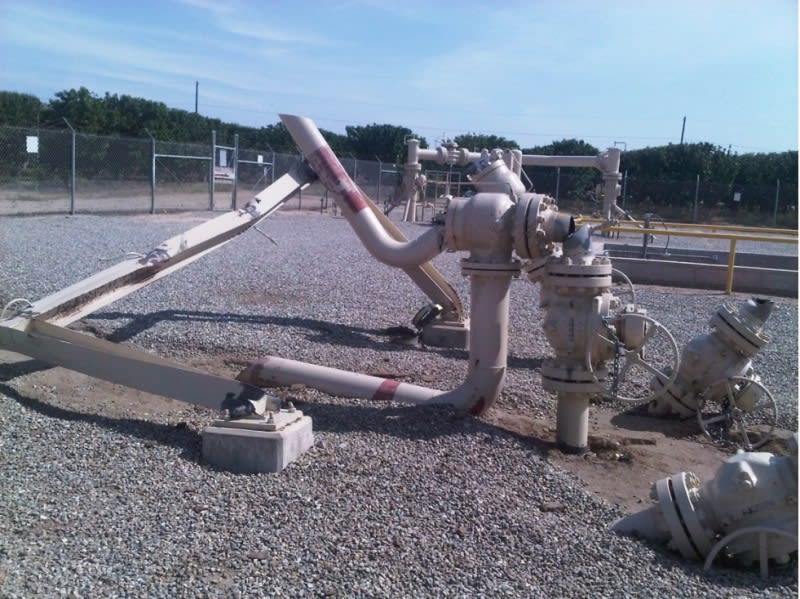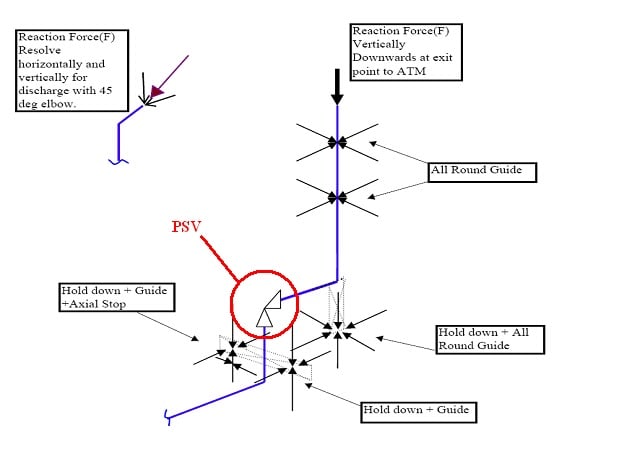Is there a reaction forced imposed on PSV inlet/discharge piping in a closed system relieving to a flare header? And should piping and structures be designed to handle that loading in steady state?
I know many companies who do not consider reaction forces on closed systems, and several who consider the transient reaction force applied at the PSV as a steady state. When considering the transient force as a steady state OCC loading (calculated with your preferred method), you are often forced to provide heavily braced structures at the PSV discharge to accommodate the load. Meanwhile, next door is a system designed assuming no reaction, no heavy reroutes or bracing, and I have not heard of these closed system PSV's jumping off of platforms and flying across a refinery.
The argument for no-reaction usually involves the following points:
- the transient force is so short lived, that the piping system cannot physically react to it before steady-state flow is established and loading goes away. I refer to this as the "ball peen hammer" argument. A ping from the hammer that can have local implications if the PSV isn't sized correctly, but otherwise, the whole system does not feel the force. As long as there are no excessively long runs, transient forces are quickly balanced.
- this method has been used for 70+ years, and closed system PSV's do not have common issues. You can stand next to a closed system psv when it pops and not witness a jump. Use an axial restraint near the discharge so that impulse forces have something to bump up against, but do not run the force as steady state.
- the codes usually have a statement saying "closed systems do not impose moments on piping systems" (but is then followed up by "but you should do a transient analysis to confirm").
The argument for applying
- no published transient analysis have been done proving the methods above, so better safe than sorry. Codes usually include an ambiguous statement that leaves room for doubt.
- we don't have the time to do transient analysis, so a conservative approach is to design to a steady state load.
- if the approach is to provide an axial restraint on the discharge, what do we tell CSA to design it to?
Can anybody cite real evidence in favor of either approach? Is there any consensus from the code committees on this? I have talked to different people in the B31.3 committee and they differ in opinion as well. Surely this has been researched and resolved at some level? Any insight is appreciated.
I know many companies who do not consider reaction forces on closed systems, and several who consider the transient reaction force applied at the PSV as a steady state. When considering the transient force as a steady state OCC loading (calculated with your preferred method), you are often forced to provide heavily braced structures at the PSV discharge to accommodate the load. Meanwhile, next door is a system designed assuming no reaction, no heavy reroutes or bracing, and I have not heard of these closed system PSV's jumping off of platforms and flying across a refinery.
The argument for no-reaction usually involves the following points:
- the transient force is so short lived, that the piping system cannot physically react to it before steady-state flow is established and loading goes away. I refer to this as the "ball peen hammer" argument. A ping from the hammer that can have local implications if the PSV isn't sized correctly, but otherwise, the whole system does not feel the force. As long as there are no excessively long runs, transient forces are quickly balanced.
- this method has been used for 70+ years, and closed system PSV's do not have common issues. You can stand next to a closed system psv when it pops and not witness a jump. Use an axial restraint near the discharge so that impulse forces have something to bump up against, but do not run the force as steady state.
- the codes usually have a statement saying "closed systems do not impose moments on piping systems" (but is then followed up by "but you should do a transient analysis to confirm").
The argument for applying
- no published transient analysis have been done proving the methods above, so better safe than sorry. Codes usually include an ambiguous statement that leaves room for doubt.
- we don't have the time to do transient analysis, so a conservative approach is to design to a steady state load.
- if the approach is to provide an axial restraint on the discharge, what do we tell CSA to design it to?
Can anybody cite real evidence in favor of either approach? Is there any consensus from the code committees on this? I have talked to different people in the B31.3 committee and they differ in opinion as well. Surely this has been researched and resolved at some level? Any insight is appreciated.



